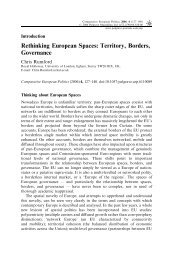Europeanisation, National Identities and Migration ... - europeanization
Europeanisation, National Identities and Migration ... - europeanization
Europeanisation, National Identities and Migration ... - europeanization
Create successful ePaper yourself
Turn your PDF publications into a flip-book with our unique Google optimized e-Paper software.
<strong>Migration</strong> <strong>and</strong> cultural diversification 105<br />
by this labour migration are, for instance, suburban neighbourhoods near the small<br />
town of Siemiatycze where comfortable houses with swimming pools mushroom,<br />
supplemented with garages equipped with automatic doors (Romaniszyn 1999a:<br />
94). The observed phenomenon is far from being modern or unique, the evidences<br />
of ‘dissemination’ of work, housing, or dress patterns, etc., from the receiving to the<br />
sending regions as a result of return migration have been reported in literature<br />
(Gabaccia 1994). For instance, at the turn of nineteenth <strong>and</strong> twentieth centuries<br />
‘baggage from America consisted not only of money, or tools, or seeds but also<br />
of ideas’, as well as clothes, food, <strong>and</strong> new customs <strong>and</strong> words (Wyman 1993: 150,<br />
182). In effect, ‘the “American houses” . . . sprang up like mushrooms after a rain’,<br />
‘seeds carried back...produced plants that were new <strong>and</strong> impressive to neighbors<br />
. . . so tobacco plants thrived in Norwegian soil, tomatoes in Finl<strong>and</strong>, <strong>and</strong> lettuce<br />
in Irel<strong>and</strong>’ (ibid. 128, 141). Today, of course, the diffusion of consumption, <strong>and</strong><br />
other cultural patterns does not result from immigration basically <strong>and</strong> exclusively,<br />
but tourism <strong>and</strong> mass media also significantly add to ‘the migration’ of lifestyles, the<br />
styles of consumption or new ideas. As shown by the examples discussed, the impact<br />
of the immigrant entrepreneurs, the ‘inflow’ of a new organisational culture brought<br />
in by the newcomers, <strong>and</strong> the importation of foreign consumption patterns by<br />
returning migrants, altogether influence <strong>and</strong> reshape the economic culture of the<br />
society involved, diversifying this sphere.<br />
Also, the social culture, understood as a realm of social relations, roles <strong>and</strong><br />
statuses, does not remain ‘immune’ to the influences stemming from the international<br />
migration. First, changes can be traced in the sphere of interpersonal<br />
contacts between the newcomers <strong>and</strong> the host society’s members. Immigrants<br />
who stay <strong>and</strong> work in the recipient country come into contact with its citizens<br />
<strong>and</strong> institutions. The interpersonal contacts between the newcomers <strong>and</strong> the<br />
indigenous people sometimes dismantle barriers of ignorance <strong>and</strong> indifference,<br />
bring the members of the two societies <strong>and</strong> cultures closer together, <strong>and</strong>, hence,<br />
link the involved societies (Romaniszyn 1999b: 127). In fact these people take<br />
on the role of contact-builders between the sending <strong>and</strong> receiving societies, who<br />
create <strong>and</strong> maintain social ties across boundaries with persons met in the migration<br />
country. This not only broadens the l<strong>and</strong>scapes (Schama 1995) rendered familiar<br />
to immigrants, but also works towards bridging the gap between the sending <strong>and</strong><br />
the receiving communities involved. Furthermore, these interpersonal contacts<br />
may further support the establishment or development of the migratory networks<br />
that augment, direct, <strong>and</strong> structure the subsequent inflows (as mentioned earlier).<br />
Second, international migration may affect the role <strong>and</strong> status changes within the<br />
migrant family, sending community, <strong>and</strong> even wider society. An excellent example<br />
is provided by recent, intensified migration of women. 5 It has the potential to<br />
improve migrant women’s status within the household, <strong>and</strong> within the wider society<br />
by providing them with opportunities to earn their own income, <strong>and</strong> by weakening<br />
traditional patriarchal authority. To some extent this potential advantage of<br />
migration may be hindered by the nature of the work in which the migrant women<br />
are engaged. When that work is low paid <strong>and</strong> involves poor working conditions<br />
with little prospect of upward mobility, it is unlikely to lead to an improvement in



